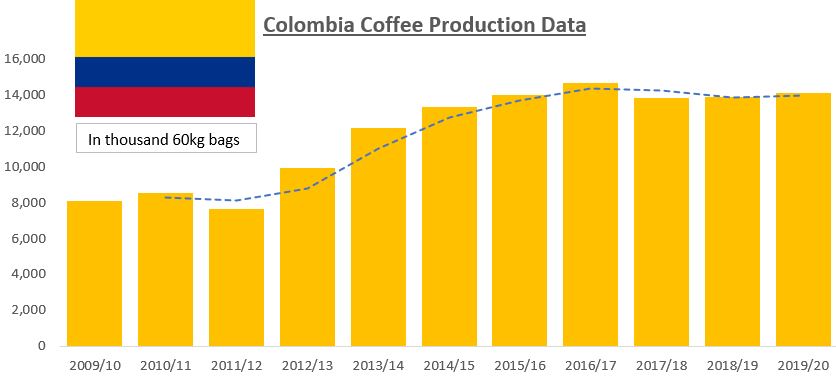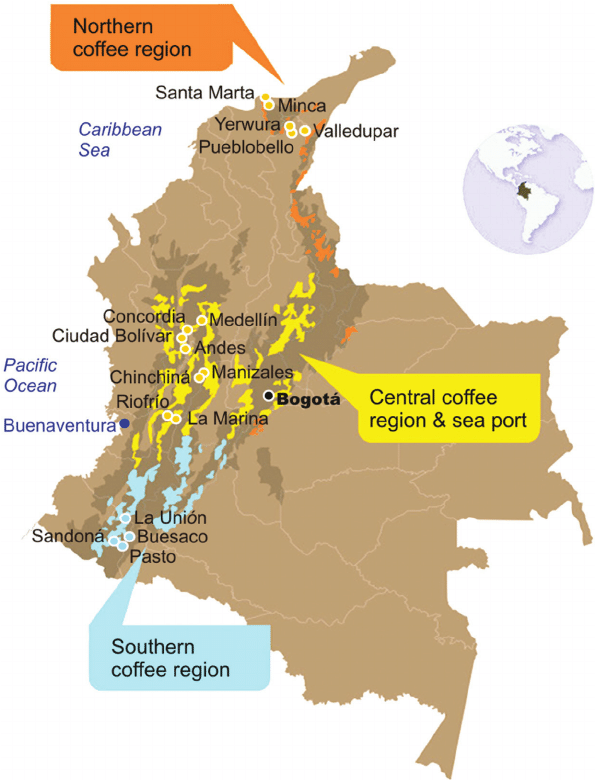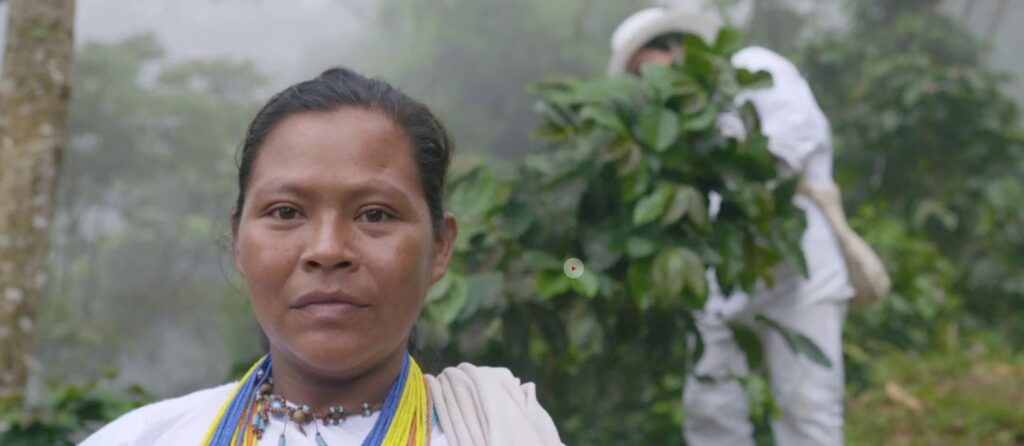Introduction
Hey coffee lovers! Ever wonder what makes Colombian coffee so amazing? Well, you’re in for a treat. Let’s embark on a flavorful journey to the heart of Colombia’s coffee world.
Imagine rolling green hills and beans basking in the perfect amount of sunshine – that’s where our story begins. We’re going to explore what gives Colombian coffee its irresistible taste and why it’s more than just a morning pick-me-up.
From the scenic plantations to the art of brewing, get ready to discover the secrets behind your favorite cup of Colombian coffee. So, grab a cup (preferably Colombian!), and let’s dive into this delicious adventure. 🌄☕
Colombian Coffee Production

The production of Colombian coffee has experienced fluctuations over the years, with recent trends showing a decline. In 2022, Colombian coffee production fell to approximately 11.1 million 60-kg bags, which was a significant drop of 12% from the nearly 12.6 million bags produced in 2021.
This decline was attributed to excess rainfall caused by the prolonged La Niña weather phenomenon over the last two and a half years. These weather conditions have had a notable impact on coffee production in Colombia, which is still the world’s largest producer of washed mild arabica coffee.
For the upcoming 2024 year, the forecast is an increase in production by 3 percent to 11.6 million bags. However, this volume is still lower than historical averages in the years preceding 2020.
Nevertheless, Colombia has been consistently one of the high-ranking counties as far as coffee production goes – It is 3rd highest just behind Brazil and Vietnam!
Coffee farming Colombia

The average size of coffee farms in Colombia is approximately 1.5 hectares. However, the sizes vary widely; about 60% of Colombian coffee farmers cultivate less than one hectare of coffee, and only 0.5% have more than 20 hectares.
Notably, 95% of Colombian coffee farms are smaller than 5 acres, indicating that the majority of coffee farms in Colombia are small and family-owned. It is estimated that there are around 500 thousand Colombian coffee families. Just like in Peru, the farmers in Colombia rely heavily on coffee economy.
Colombian coffee farming is a detailed process starting with seed selection, sown in seedbeds for about two months, then moved to nurseries. The soil is meticulously prepared for planting, often in shaded areas to protect the crop.
Harvesting is selective, with only ripe beans picked manually. The coffee beans undergo pulping to remove the outer pulp, followed by washing and fermentation, which is crucial for flavor development. Drying is carefully done to ensure evenness.
Quality control is rigorous, with inspections from the National Federation of Coffee Growers of Colombia. The threshing process involves removing the parchment layer, followed by sorting beans by size.
Finally, roasting, usually medium for Colombian coffee, determines the flavor, aroma, and body of the coffee. This comprehensive process, combined with Colombia’s ideal coffee-growing climate and terrain, contributes to the unique quality of Colombian coffee.
Coffee growing regions in Colombia

The coffee-growing regions in Colombia can be categorized based on their geographical locations:
Northern Colombia:
- Sierra Nevada de Santa Marta: Located near the Caribbean coast, this area is unique for its organic coffee cultivated by indigenous communities. The region is known for its rich and robust-flavored coffee.
Central Colombia:
- The Coffee Triangle (Eje Cafetero): Comprising Caldas, Quindío, and Risaralda, this region is a UNESCO World Heritage site known for its high-quality coffee.
- Antioquia: One of Colombia’s largest coffee-producing regions, located in the northwest, renowned for its diverse microclimates.
- Tolima: Situated in the center-west of Colombia, Tolima’s varied climates and altitudes produce a wide range of coffee flavor profiles.
Southern Colombia:
- Huila: Known for its bright acidity and rich flavors, often with floral and fruity notes, this region is located in the southwest.
- Cauca: Recognized for its high-altitude coffee farms, Cauca produces distinct coffee, often with bright acidity and fruit-forward notes.
- Nariño: Bordering Ecuador and the Pacific Ocean, it is ideal for coffee growing due to its high altitude and volcanic soils, producing delicate and complex flavors.
Eastern Colombia:
- Santander and Norte de Santander: These northeastern regions are known for traditional coffee-growing methods, yielding coffee with a strong body and pronounced bitterness.
Why is Colombian Coffee so special?
Colombian coffee is considered special and highly valued worldwide for several key reasons:
- Ideal Growing Conditions: Colombia’s geographical location along the equator provides a consistent climate ideal for coffee growing, with plenty of rainfall, high altitudes, and a range of temperatures. These conditions are perfect for growing Arabica beans, known for their smooth, mild flavor and aromatic qualities. The varying altitudes and climates across Colombia’s coffee-growing regions contribute to a wide range of coffee profiles. Each region produces beans with unique flavors, from fruity and floral notes to rich and chocolaty undertones.
- High Altitude Cultivation: Much of Colombia’s coffee is grown at high altitudes, where cooler temperatures slow the growth of coffee cherries. This prolonged maturation process allows for the development of a more refined and complex flavor profile in the beans.
- Focus on Arabica Beans: Colombia primarily produces Arabica coffee, which is generally considered higher quality than Robusta due to its smoother, sweeter taste and lower caffeine content. Arabica beans are more challenging to grow, requiring specific climatic conditions that Colombia abundantly provides.
- Quality Control and Reputation: The National Federation of Coffee Growers of Colombia (Federación Nacional de Cafeteros de Colombia) plays a significant role in maintaining high standards. They provide support to farmers and oversee quality control measures to ensure the coffee that is exported meets strict quality standards.
- Cultural Significance and Branding: Colombian coffee has been effectively branded and marketed globally, partly thanks to iconic symbols like Juan Valdez. This has helped in establishing a strong identity and reputation for Colombian coffee as a premium product.
Most popular Colombian Coffee Brands
Colombia is home to many renowned coffee brands, each offering unique flavors and qualities that represent the rich coffee culture of the country. Some of the most popular Colombian coffee brands include:

- Juan Valdez: Perhaps the most internationally recognized Colombian coffee brand, Juan Valdez is named after the fictional character that has long been the face of Colombian coffee farmers. They offer a wide range of coffee products, including single-origin and blended coffees.
- Oma: A well-known Colombian brand, Oma is recognized for its high-quality coffee beans and also operates a chain of coffee shops throughout Colombia.
- Sello Rojo: This brand is a staple in many Colombian households and is known for its traditional flavor profile. Sello Rojo has a long history in the Colombian coffee market and is appreciated for its consistency and quality.
- Café de Colombia: This is more of a national brand that represents a variety of Colombian coffee producers. It’s known for its high standards and the promotion of Colombian coffee worldwide.
- Colcafé: A part of the Grupo Nutresa, Colcafé specializes in instant and ground coffee and is one of the largest coffee companies in Colombia.
- Café Quindío: Originating from the heart of the Colombian coffee region, Café Quindío is known for its artisanal approach to coffee production and its rich, aromatic coffee.
- Amor Perfecto: A pioneer in the specialty coffee movement in Colombia, Amor Perfecto is renowned for its high-quality, award-winning coffees and for promoting direct relationships with farmers.
- Café San Alberto: This brand is known for its gourmet coffee, often regarded as one of the finest in Colombia. Café San Alberto’s focus on quality is evident in their meticulously crafted coffee products
Colombian Beans Flavor Profile
The most popular and widely recognized flavor profile of Colombian coffee beans is characterized by a well-balanced combination of mildness, bright acidity, and rich aroma. This profile typically includes:
- Mild and Well-Balanced Taste: Colombian coffee is often appreciated for its smooth, mild taste that is easy on the palate, making it appealing to a broad range of coffee drinkers.
- Bright, Crisp Acidity: One of the signature characteristics of Colombian coffee is its lively acidity. This is often perceived as a crisp, clean quality in the cup, contributing to the coffee’s overall refreshing feel. The acidity can sometimes have citrusy or fruity undertones.
- Sweet Notes: Colombian coffees frequently exhibit a natural sweetness, which can manifest as hints of caramel, chocolate, or vanilla. This sweetness balances the acidity and adds to the overall richness of the coffee.
- Fruity and Nutty Undertones: Depending on the region and processing, Colombian beans can have subtle notes of fruits like berries, apples, or tropical fruits, as well as nutty flavors like almonds or walnuts.
- Medium Body and Rich Aroma: Colombian coffees generally have a medium body, offering a pleasing mouthfeel. They are also known for their rich and aromatic qualities, which can range from floral and fruity to chocolaty and nutty.
Main coffee organization in Colombia
In Colombia, the main organization responsible for controlling coffee standards and representing the interests of coffee farmers is the Federación Nacional de Cafeteros de Colombia (FNC), or the National Federation of Coffee Growers of Colombia. The FNC is a non-profit business association founded in 1927 and has played a crucial role in the Colombian coffee industry.
The FNC oversees quality control standards for Colombian coffee. It ensures that coffee exported from Colombia meets certain quality criteria, maintaining the high reputation of Colombian coffee in the global market.
In addition, through its research arm, Cenicafé (the National Coffee Research Center), the FNC conducts extensive research on coffee cultivation, disease control, and sustainability practices. This research helps in improving the quality and yield of Colombian coffee.
Two specific initiatives that come to mind are:
- Development of Rust-Resistant Coffee Varieties: Cenicafé, the research arm of the FNC, developed the Castillo variety of coffee, which is resistant to coffee leaf rust (Hemileia vastatrix). This disease-resistant variety has been crucial in helping farmers manage coffee leaf rust outbreaks that can significantly impact yield and quality.
- Pension Fund for Coffee Growers: The FNC established a pension fund for coffee farmers, providing them with financial security. This initiative is particularly important in a sector where many farmers are smallholders who might not have other means of financial support in their older age.
The FNC’s comprehensive approach to managing the coffee sector has been instrumental in enhancing the global stature of Colombian coffee and supporting the sustainability of the coffee industry in Colombia.
Conclusion: A Cup Filled with Stories
Each cup of Colombian coffee is a blend of rich flavors, cultural heritage, and the efforts of countless individuals. From the small-scale farmer in the Andean hills to the barista who serves it, Colombian coffee is a testament to tradition, quality, and innovation.
So the next time you savor a cup of this delightful brew, remember, it’s not just coffee – it’s a story in every sip.
Sources and Related Articles
- https://colombia.travel/en/blog/coffee-farms-in-colombia
- https://e360.yale.edu/features/as-climate-changes-colombias-small-coffee-farmers-pay-the-price
- https://coffeegeography.com/2023/05/24/annual-coffee-report-on-colombia-2023
- https://ravecoffee.co.uk/blogs/news/what-makes-colombian-coffee-special
- https://www.coffeebeancorral.com/blog/post/2020/11/10/colombian-coffee-guide
- Internation Coffee Organization (Production Data)

